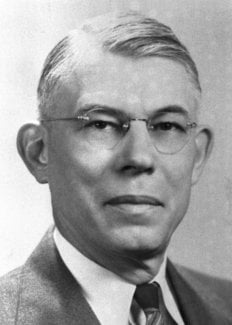Edward A. Doisy
Biographical

Edward Adelbert Doisy was born at Hume, Illinois, on November 13, 1893. He was the son of Edward Perez and his wife Ada, née Alley.
He was educated at the University of Illinois, where he took his A.B. degree in 1914 and his M.S. degree in 1916. From there he went to Harvard University, where he took his Ph.D. degree in 1920.
From 1915 until 1917 he was assistant in biochemistry at Harvard Medical School and from 1917 until 1919 he did war service in the Sanitary Corps of the United States Army. From 1919 until 1923 he was Instructor, Associate, and Associate Professor at Washington University School of Medicine and in 1923 he became Professor of Biochemistry at St. Louis University School of Medicine. In 1924 he was appointed Director of the Department of Biochemistry.
Doisy has been concerned chiefly with biochemical studies of the sex hormones and vitamins K1 and K2. At the St. Louis School of Medicine he worked in collaboration with Edgar Allen on the refinement of the vaginal cytology (or smear) technique for the big-assay of the potency of oestrogenic hormones in ovariectomized rats.
In 1929-1930 he succeeded in isolating oestrone, a feat independently accomplished at about the same time by Butenandt in Germany.
In 1936, in collaboration with MacCorquodale and Thayer, he recovered oestradiol from the ovaries of swine and estimated its concentration in the liquor folliculi.
In 1939 he succeeded in isolating vitamin K, which had been found, in 1935, by Almquist and Stokstad in alfalfa. Vitamin K was isolated in an almost pure form as a yellow oil by Henrik Dam, in collaboration with Paul Karrer.
In 1940 Doisy, in collaboration with Thayer, MacCorquodale, McKee, and Binkley, studied the analogues of vitamin K and established the distinction between vitamin K1 which they isolated from alfalfa, and vitamin K2, isolated from fish meal, which has an action similar to that of vitamin K1, but has a slightly different constitution.
Vitamin K was synthesized in 1939 by Louis Frederick Fieser and by Almquist and Klose, and by Doisy and his collaborators.
For their work on vitamin K, Doisy and Dam were jointly awarded the Nobel Prize in Physiology or Medicine for 1943.
In addition to the work just mentioned, Doisy has improved the methods used for the isolation and identification of insulin and he has also made important contributions to the knowledge of antibiotics and blood buffer systems, and bile acid metabolism.
In 1939 Doisy published, in collaboration with Edgar Allen and C. H. Danforth, a book entitled Sex and Internal Secretions.
Apart from several medals and awards, Doisy holds honorary degrees of Yale, Washington, Chicago, Illinois, St. Louis, Central College; Gustavus Adolphus College, and Paris Universities. In 1932 and 1935, he was a member of the League of Nations Committee for the Standardization of Sex Hormones. He was President of the American Society of Biological Chemists in 1943-1945, of the Endocrine Society in 1949-1950, and of the Society for Experimental Biology and Medicine in 1949-1951.
In 1955 his Department was renamed the Edward A. Doisy Department in his honour.
Doisy married Alice Ackert in 1918. They live at St. Louis, Mo, and have four sons, Edward A. Jr., Robert, Philip, and Richard.
This autobiography/biography was written at the time of the award and first published in the book series Les Prix Nobel. It was later edited and republished in Nobel Lectures. To cite this document, always state the source as shown above.
Edward A. Doisy died on October 23, 1986.
Nobel Prizes and laureates
Six prizes were awarded for achievements that have conferred the greatest benefit to humankind. The 14 laureates' work and discoveries range from quantum tunnelling to promoting democratic rights.
See them all presented here.
